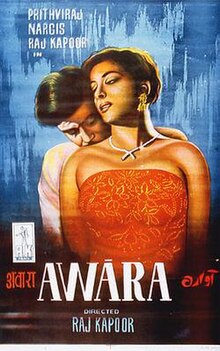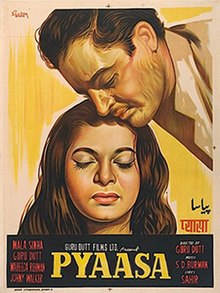Lists are made and changed frequently, as times, trends and tastes change. But there films that always make the cut—those vintage movies that every generation of film lovers must see to understand that there is more to Hindi cinema than making 100 crores. There was art, passion, social commitment and also an understanding of the pulse of the audience. These are films that are part of Bollywood history. Some are available on streaming platforms, most on YouTube, and other online sources
10 vintage films in order of release:
Kismet (1943):

This Ashok Kumar-Mumtaz Shanti starrer, directed by Gyan Mukherjee, was the top grosser and longest running film of all time—187 weeks at Kolkata’s Roxy cinema—till DDLJ broke the record. It was the first film to use the lost-and-found plot in Hindi films, which was then picked up by other filmmakers down the years. The romance-cum-crime drama was about a good-hearted pickpocket who decides to help a damsel in distress and discovers after many twists and turns that he is the long lost son of a rich man. The film had sneaked in a patriotic song –Dur hato aye duniya walon, Hindustan hamara hai-– right under the noses of the British censors. The music by Anil Biswas with Kavi Pradeep’s lyrics, contributed to the film’s massive success.
Awara (1951):

Even today, Russians can hum the title track of this Raj Kapoor film, and in the 1950s, many kids in East Europe were named Raj and Nargis. This could be said to be the first crossover film before the term was coined. Written by KA Abbas and directed by Kapoor, the story of a poor thief, who eventually comes face to face with his estranged father (Prithviraj Kapoor) in court, as his lady love (Nargis) defends him, the film and its music by Shankar-Jaikishen was a craze in Asia, Africa, the Middle East and the Caribbean, apart from the Soviet Union. Raj Kapoor’s tramp character inspired by Charlie Chaplin, stayed with him for many films after this.
Do Bigha Zamin (1953):

Bimal Roy has made many successful films, but this heart-rending portrayal of the poor in India remains his greatest masterpiece. Inspired by Italian neo-realistic cinema, particularly Vittorio De Sica’s Bicycle Thieves, the film about a debt-ridden farmer Shambhu’s desperate attempt to save his land was among the earliest of the parallel cinema movement in India. Balraj Sahni’s performance as the farmer, who migrates to Kolkata and pulls a rickshaw to earn money, was one of the greatest in Indian films. Based on a Rabindranath Tagore story, with a screenplay by Hrishikesh Mukherjee, the film also starred Nirupa Roy and Ratan Kumar as Shambhu’s wife and son.
Pyaasa (1957):

Guru Dutt starred in his own brooding classic about Vijay, an idealistic poet in a materialistic world. The film co-starred Waheeda Rehman as Gulabo, a prostitute in love with Vijay, who cares about him when the others in his life either reject or deceive him. With stunning VK Murthy cinematography, studded with melodious SD Burman songs and evocative lyrics by Sahir Ludhianvi, the film is a strong indictment of the greed and callousness of the modern world.
Mother India (1957):

Mehboob Khan’s epic about Radha (Nargis), who fights to raise her children with great difficulty, but never giving up on her principles is seen as an example of female empowerment. The shocking climax in which she shoots her own outlaw son (played by Sunil Dutt, who went on to marry Nargis) is still one of the most powerful in Indian cinema. The film, a remake of the director’s own earlier film, Aurat, won every award and accolade, was a huge box-office success and the first Indian film to be nominated for an Academy Award.
Mughal-e-Azam (1960):

K Asif took a decade to make this grand historical romance, but chiselled every frame to perfection. Starring Dilip Kumar as Prince Salim who rebels against his father Emperor Akbar (Prithviraj Kapoor) for the love of a courtesan, Anarkali (Madhubala), the film was the most expensive ever for the time, and also the top-grossing, with exquisite sets, costumes and 12 unforgettable songs composed by Naushad. It was a no expense spared work of cinematic brilliance, that filmmaker could never surpass.
Ganga Jumna (1961):

Written and produced by Dilip Kumar, starring himself, his brother Nasir Khan and Vyjayanthimala, directed by Nitin Bose, the film was a strong portrayal of the evils of feudalism, that lead Ganga to become a bandit, while his brother Jumna becomes a cop who is tasked with nabbing the notorious dacoit. The film’s plot about two brothers on opposite sides of the law was much imitated. The film with music by Naushad, was a huge hit, won several awards and is among the best Hindi films ever made.
Guide (1965):

Vijay Anand turned RK Narayan’s novel into an extravagant romantic drama, in which the flamboyant Raju Guide (Dev Anand), due to a set of unhappy circumstances, becomes a guru figure. His love story with his protégé, the dancer Rosie (Waheeda Rehman) ends with him in prison. His reluctant transformation into a spiritual guide to innocent villagers who believe in him, leads to his redemption. With a brilliant SD Burman score and career best performance by Dev Anand, the film is as evergreen as its star.
Anand (1971):

In a long career full of wonderful films, this film is a jewel in Hrishikesh Mukherjee’s crown. Anand (Rajesh Khanna), is terminally ill with a few months left to live, but he brings cheer into the lives of people he encounters, including a dour doctor (Amitabh Bachchan). Only Mukherjee, with some help from Gulzar’s dialogue, could have made a happy film about death. As the protagonist says, life should be big, not long.
Sholay (1975):

Ramesh Sippy and Salim-Javed at the peak of their powers and a curry western becomes embedded into Indian popular culture, with lines from the film quoted widely in everyday conversations. Two petty crooks (Dharmendra-Amitabh Bachchan) are hired by Thakur Baldev Singh (Sanjeev Kumar) to come to Rampur and fight the dreaded dacoit Gabbar Singh (Amjad Khan in a sensational debut). It is rare that a film and its characters remain in the minds of audiences decades later.








